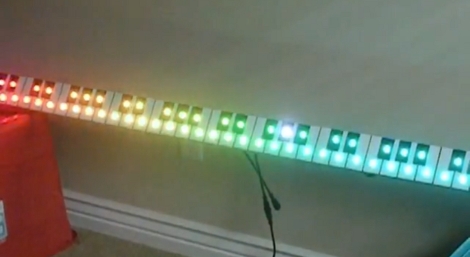
This keyboard display has an RGB LED for each key that is addressable through the common stage lighting protocol, DMX. The project video, seen after the break, does a good job of walking us through the concept. By using a MIDI to DMX converter box [John] can show MIDI signals coming from a keyboard on the appropriate key of the display. By further monkeying with the firmware in the converter box he shows a plasma effect on the whole keyboard, making the corresponding light for each pressed key pop out in bright white. Jump to about 3:45 to hear and see “Sweet Child o’ Mine”.
This isn’t the first time [John’s] been caught with a slew of blinking lights. He helped create the giant LED Christmas tree that brightened up our holiday.
[youtube=http://www.youtube.com/watch?v=CZvEqP5JSvA]















Quote: Jump to about 3:45 to hear and see “Sweet Child o’ Mine”.
That was awesome. Why no video link in the article though?
Eh.
@Mikey: Oops, must slipped my mind when I got to the end of the article. Fixed.
I’d say this hardly qualifies as a hack.
He is using a TON of off the shelf hardware, and even the LED display looks like a cut apart LED tube you see in clubs and stuff. The DMX and MIDI hardware is all pretty much stock, and the ‘modification’ to the DecaBox firmware can be done through settings with no need to hack anything.
If you build this with a PIC or ATMEL I’ll be super impressed, but this is just a complicated connection of MIDI and DMX controllers/converters.
@M4C – You’re correct that the pixel mapping software, Enttec dongle and Garage Band software are available off-the-shelf.
The other bits, specifically the DecaBox bridge and the T3 node controller, were developed in-house. The DMX/MIDI merging code was written at the firmware level, and isn’t accessible through any of the stock settings.
I contemplated writing a plasma generator in the DecaBox itself, but time invested vs results expected just didn’t make sense.
It’s only off-the-shelf in that he is soon going to be selling it. He designed it all, and has now gotten a fab in China to manufacture it. He designed it all for his Christmas display.
…
Casio Light keys keyboard do it allinone but I think dmx (or osc) multicast shared music will be a true elearning system for learning music in future.
Why not implement altogheter?
;)
…
Wow, if this had been around when I was wanting to learn to play the piano, I definitely would have stuck with it.
I think I might pick it back up anyway, this is really cool.
Though I’m not terribly impressed with this particular “hack”, I must say that I’d really like to see more DMX hacks around here.
“If you build this with a PIC or ATMEL I’ll be super impressed, but this is just a complicated connection of MIDI and DMX controllers/converters.”
Ah, the old “No Arduino, not a hack” argument.
I find it amusing that nothing the guy you’ve named yourself after counts as a “hack” by your standards.